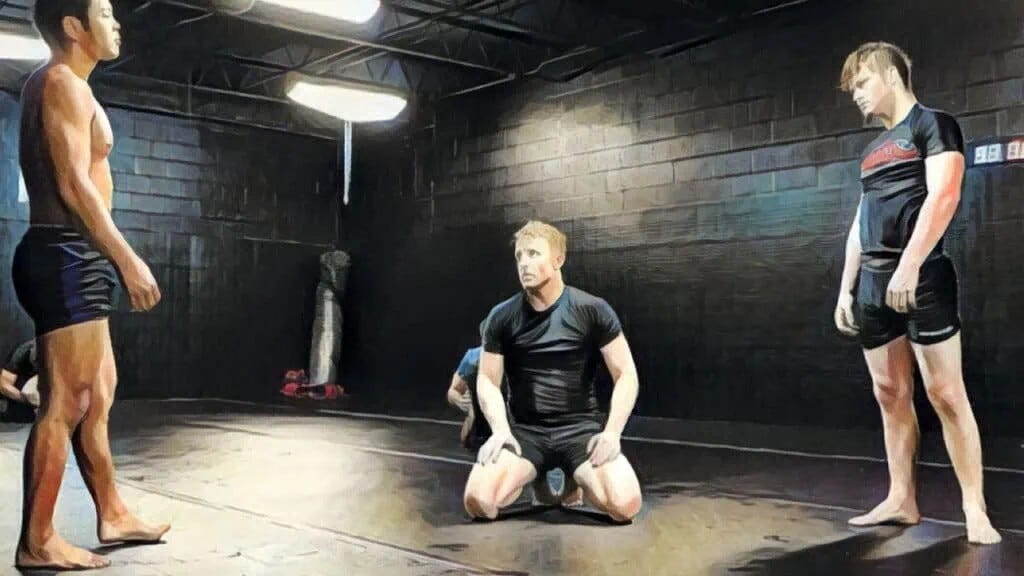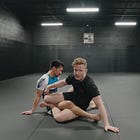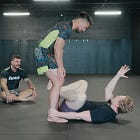A lot of people are already into the “eco” boat. I’ve been in for a while. One of the problems that I have experienced and that I see everywhere when trying to design games is progression. How do we manage the situation at different levels so we can get that behavior we are looking for?
I’ve been there, as I said. I try a game I saw online, or maybe I created myself for my students, and they aren’t capable of completing the task at all. It can be frustrating.
I’m not a full time coach. I’m a competitor and a writer first. That being said, I want my guys to get better at jiu-jitsu, and while I could just say, “Well, they’re just dumb”—which sometimes I’m tempted to do—I rather take responsibility and do my best to see what I can do better for them.
That brought me to Malaga, Spain. There’s a camp called "Figure It Out," featuring both the infamous Greg Souders and also Max Bickerton, who is the head coach of Grappling Collective in London and coach of ADCC Trials winner and multiple times world champion Injana Goodman.
I actually came here from an athlete’s perspective, but I’m also getting a lot as a coach, and that’s exciting.
Obviously, I can't share with you exactly what we are doing in the camp, but I wanted to talk about an idea that has been really consistent on how the practices are being done in the camp.
I'm not exaggerating when I say that this idea, while being extremely simple, is a game changer in the way you create a practice, and it’s extremely useful to introduce new skills for beginners, which is one of the main problems people experiment with eco. Let’s look at it.
Maintaining The Condition
I’ve talked about conditions before. At the end of the article, I’ll list all the resources so you can go check it out, so you may want to go there first if you don’t know what I mean by condition.
I’m going to give you a quick definition, anyway. A condition is something we have to do in order to get an effect. One condition can have multiple effects. Simple, right?
An example of a condition would be inside position. There are multiple effects possible with that condition, like destabilization, access to the hips via entanglement, pinning someone to the mat…
So, what do I mean by “maintaining the condition”?
A condition can have multiple effects, as I said. That’s a lot of information for a completely new player. Also, the other player is going to be trying to cancel the condition, which puts even more stress on the new player. And we are not even talking about starting away from the condition and asking a new player to get there.
So, instead of stressing out your students with that much variability, reduce the “noise”. Start with the condition you want them to work on, and just ask them to maintain it as long as possible.
For example, you could start someone in a chest to chest pin and give them already the condition of getting under the elbows. From there, their job would be to stay under the elbows in any way they can, for as much time as they can. Nothing else.
Obviously, the defending player would have the opposite goal: getting his elbows back to their rib cage so there’s nothing under or behind them. You always need both players to have opposite goals.
So, you decide the condition you want your students to work on (getting behind elbows, head and arms, inside foot position…), and then you give them already that condition and only ask them to maintain it.
Giving the Condition a Function
Once your students were able to feel what it’s like to have that condition and try to maintain it, you can’t stop there. You need to give them a reason to search that condition in the first place.
We do that by giving a function to the condition.
Let’s keep going with the chest to chest pin example. Your students just played a game trying to stay under the elbows, but they still haven’t discovered the function of it other than facilitating pinning, which they probably would already experience. Remember, one condition has multiple effects.
So, you have to think of your intention as a coach. What effects do you want your students to experiment with that condition? In this case, let’s say that I want them to use the condition of staying under the elbows to capture a head and an arm together, which would later on lead to strangulation.
The way this may work is starting them again with the chest to chest pin under the elbows and then give them the goal of, while staying on top and under the elbows, trying to isolate an arm and the head together and trap them in between their arms, legs, or whatever way they find.
That’s how you give a function to a condition, and to do that, it’s extremely important you have a clear intention on why you are doing what you are doing. If you don’t have a clear intention, your students won’t either.
Achieving the Condition
I don’t think a complex definition is necessary here. You gave them a condition and it’s function. Now you have to get them to experiment how to get to that condition in the first place.
Now, this can be hard because you can start them from different situations and that would change the nature of the task. So how do you do this without making it impossible for our students?
It depends on the level of the students. The more skilled the student is, the further away we want to start them from the condition we want them to achieve. In contrast, the less skill the student is, the closer we want them to start.
So you could ask a experienced guy to start from a standing situation and try to get to the condition you want. That would actually be beneficial for him because it forces the advanced student to experiment and solve new problems to achieve the same thing.
As for beginners, you want them to start as close as possible to the condition. So if you want them to get under the elbows, starting them past the legs with their hands locked around their partner’s waist while he’s laying on his side is a good example of this.
You can give them the task to look to remove their partner’s hands out of the way and get their own arms under or behind the elbows. You don’t have to keep the function, because maybe that would be too much for beginners, but it depends on your room.
Again, the defensive player would have any opposite goal. He would try to keep his hands on the top player while trying to get his legs back in front (for example). The top player would have to deal constantly with the hands in order to get under the elbows.
That's how you get a new player to achieve a condition after they already experiment it.
Summary
I genuinely think this is one of the most straightforward articles I have ever made, but a little summary at the end can’t hurt.
Start them with the condition already and give them the task of maintaining it for as long as possible.
Have a clear intention on what effect you want your students to experiment with, and then give the condition that function.
Once your students have experienced both the condition itself and its function, get them to achieve the condition.
The more skilled the player is, the further away we want them from the condition. The less skilled the player is, the closer we want them to the condition.
Keep both players with opposite goals.
Have this in mind, and your students will thank you.
Resources
My article (kind of old) on condition and effects:
Standard Jiu-Jisu channel’s video on condition and effect:
My article on iterative practice with Standard Jiu-Jitsu video linked (really recommend understanding iterative practice):
So…
This is not the only way to design a practice. It’s just a really effective framework you can use, but if you can learn something from this type of training, it's that adaptability matters most. So, keep that in mind when designing your training sessions.
Honestly, the training I’m having in Málaga is the best that I ever had in my whole jiu-jitsu journey. Everything has purpose. No stupid 20 minute long calisthenics warm up before class. No three random and unrelated techniques and then rolling. Everything here is live and intentional.
I’m taking a lot from this training for my growth as both an athlete and a coach. Also, there are some killers in the room. Today I just trained with a brown belt master world champion, so that was amazing.
Both Greg and Max have been super nice with me, and I’m really happy to get to know them in person and train with them. Greg is more or less my idol right now, while I got genuinely surprised with Max class design for good.
Also, I want to talk about something serious. As I said, ADCC Trials winner, Injana Goodman, is training under Max. She won the trials, but she’s not getting his ticket to the worlds and will have to do another trials in order to get there. That’s extremely unfair to her. There’s literally no reason to not give the trials winner the ticket to the worlds, but every woman who wins the first trials won’t have that opportunity.
We can change that by putting pressure on ADCC and FloGrappling. We need fairness.
That’s why I’m asking you to sign this petition, and if possible, spam it everywhere. Your help is needed.
Anyway, that’s all I had to say. I hope it helps you design your training sessions, both as an athlete and as a coach. Have a great day!





Nice job
great article
i've been experimenting with eco games and specific conditions in instruction
if anything i need to break it down to further specificity for newer grapplers